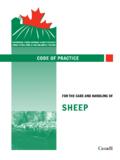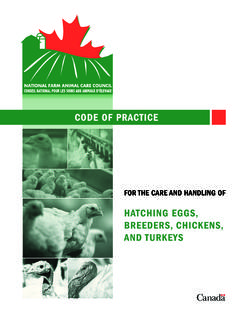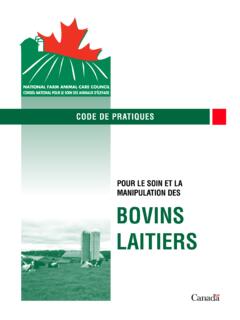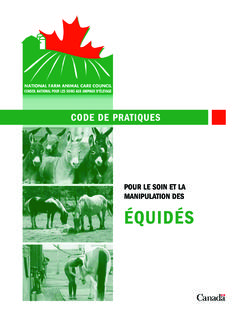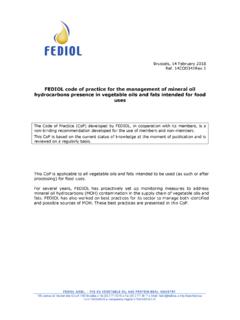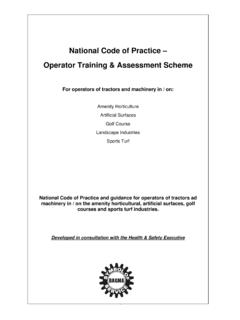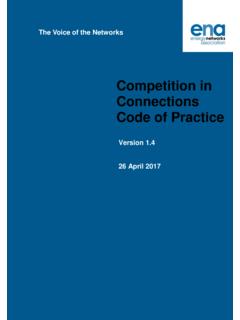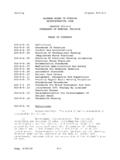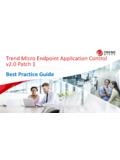Transcription of PULLETS AND LAYING HENS - NFACC
1 FOR THE CARE AND HANDLING OFPULLETS AND LAYING HENSCODE OF PRACTICECODE OF PRACTICE FOR THE CARE AND HANDLING OF PULLETS AND LAYING hens - 2017iiISBN 978-1-988793-00-9 (book) ISBN 978-1-988793-01-6 (electronic book text)Available from: Egg Farmers of Canada 21 Florence Street, Ottawa, ON K2P 0W6 Telephone: 613-238-2514 Fax: 613-238-1967 Website: Email: For information on the code of Practice development process contact: National Farm Animal Care Council ( NFACC ) Website: Email: Also available in French Copyright is jointly held by Egg Farmers of Canada and the National Farm Animal Care Council (2017)This publication may be reproduced for personal or internal use provided that its source is fully acknowledged.
2 However, multiple copy reproduction of this publication in whole or in part for any purpose (including but not limited to resale or redistribution) requires the kind permission of the National Farm Animal Care Council (see for contact information).AcknowledgmentFunding for this project has been provided through the AgriMarketing Program under Growing Forward 2, a federal provincial territorial contained in this publication is subject to periodic review in light of changing practices , government requirements and regulations. No subscriber or reader should act on the basis of any such information without referring to applicable laws and regulations and/or without seeking appropriate professional advice. Although every effort has been made to ensure accuracy, the authors shall not be held responsible for loss or damage caused by errors, omissions, misprints or misinterpretation of the contents hereof.
3 Furthermore, the authors expressly disclaim all and any liability to any person, whether the purchaser of the publication or not, in respect of anything done or omitted, by any such person in reliance on the contents of this image (top left and right) courtesy of Gray & Sons LimitedCover Image (bottom) courtesy of Egg Farmers of CanadaPerching Diagram (p. 25) Illustration by Jeremy Prapavessis code OF PRACTICE FOR THE CARE AND HANDLING OF PULLETS AND LAYING hens - 20171 Table of ContentsPreface ..3 Introduction ..5 Glossary ..7 pullet Housing and pullet Housing .. Housing Equipment: Design and Flooring .. Feeders and Space Allowance .. Special Considerations for Multi-Tier Rearing Systems .. Perches .. Receiving and Brooding Chicks.
4 Lighting .. pullet Rearing and Reducing Fear ..16 Housing Systems for Housing and Equipment: Design and Construction .. Flooring .. Feeders and Waterers .. Enriched Cage and Non-Cage Housing Systems .. Transitioning from Conventional Cages .. Space Allowance .. Nesting .. Perching .. Foraging and Dust Bathing .. Special Considerations for Multi-Tier Systems .. Access to Outdoors .. Housing and Range: Design and Construction .. Range Management .. Feeders and Waterers: Access to Outdoors ..29 Barn Environmental Ventilation and Air Quality .. Temperature .. Noise .. Lighting .. Litter Management ..34 Feed and Feed and Water Management .. Nutrition .. Nutrition to Manage Bone Health.
5 Water ..38 Section 1 Section 2 Section 3 Section 4 code OF PRACTICE FOR THE CARE AND HANDLING OF PULLETS AND LAYING hens - 20172 Health Management and Husbandry pullet Sourcing and Transition to Lay .. Health Management Plan .. Skills Related to Flock Management .. Disease Prevention and Management .. Sanitation .. Pest Control .. Inspections .. Sick and Injured Birds .. Harmful Behaviour .. Feather Pecking and Cannibalism ..45 On-Farm Beak Trimming .. Panic, Hysteria, and Smothering .. Controlled Moulting .. Emergency Management and Preparedness ..48 Handling and Pre-Transport Planning .. Feed and Water: Pre-Loading .. Fitness for Transport .. Handling and Catching .. Loading and Unloading.
6 Facilities Design and Maintenance .. On-Farm Euthanasia Plans .. Skills and Knowledge .. Decision Making around Euthanasia .. Methods of Euthanasia ..56On-Farm Planned On-Farm Depopulation .. Emergency On-Farm Depopulation ..59 References ..60 AppendicesAppendix A - Transitional and Final Housing Requirements for Enriched Cages ..63 Appendix B - Transitional and Final Housing Requirements for Non-Cage Housing ..64 Appendix C - Guidelines for Transporting Poultry ..66 Appendix D - Example Euthanasia Decision Guidance ..67 Appendix E - Acceptable Methods of Euthanasia ..68 Appendix F - Resources for Further Information ..69 Appendix G - Participants ..71 Appendix H - Summary of code Requirements ..72 Section 7 Section 8 Section 6 Section 5 code OF PRACTICE FOR THE CARE AND HANDLING OF PULLETS AND LAYING hens - 20173 PrefaceThe National Farm Animal Care Council ( NFACC ) code development process was followed in the development of this code of Practice.
7 The code of Practice for the Care and Handling of PULLETS and LAYING hens replaces its predecessor developed in 2003 and published by the Canadian Agri-Food Research Council (CARC). The Codes of Practice are nationally developed guidelines for the care and handling of farm animals. They serve as our national understanding of animal care requirements and recommended practices . Codes promote sound management and welfare practices for housing, care, transportation, and other animal husbandry practices . Codes of Practice have been developed for virtually all farmed animal species in Canada. NFACC s website provides access to all currently available Codes ( ). The NFACC code development process aims to: link Codes with science ensure transparency in the process include broad representation from stakeholders contribute to improvements in farm animal care identify research priorities and encourage work in these priority areas write clearly to ensure ease of reading, understanding and implementation provide a document that is useful for all stakeholders.
8 The Codes of Practice are the result of a rigorous code development process, taking into account the best science available for each species, compiled through an independent peer-reviewed process, along with stakeholder input. The code Development process also takes into account the practical requirements for each species necessary to promote consistent application across Canada and ensure uptake by stakeholders resulting in beneficial animal outcomes. Given their broad use by numerous parties in Canada today, it is important for all to understand how they are intended to be interpreted. Requirements - These refer to either a regulatory requirement or an industry imposed expectation outlining acceptable and unacceptable practices and are fundamental obligations relating to the care of animals.
9 Requirements represent a consensus position that these measures, at minimum, are to be implemented by all persons responsible for farm animal care. When included as part of an assessment program, those who fail to implement Requirements may be compelled by industry associations to undertake corrective measures or risk a loss of market options. Requirements also may be enforceable under federal and provincial regulation. Recommended practices - code Recommended practices may complement a code s Requirements, promote producer education, and can encourage adoption of practices for continual improvement in animal welfare outcomes. Recommended practices are those that are generally expected to enhance animal welfare outcomes, but failure to implement them does not imply that acceptable standards of animal care are not met.
10 Broad representation and expertise on each code Development Committee ensures collaborative code development. Stakeholder commitment is key to ensure quality animal care standards are established and OF PRACTICE FOR THE CARE AND HANDLING OF PULLETS AND LAYING hens - 20174 Preface (continued)This code represents a consensus amongst diverse stakeholder groups. Consensus results in a decision that everyone agrees advances animal welfare but does not imply unanimous endorsement of every aspect of the code . Codes play a central role in Canada s farm animal welfare system as part of a process of continual improvement. As a result, they need to be reviewed and updated regularly. Codes should be reviewed at least every five years following publication and updated at least every ten years.


